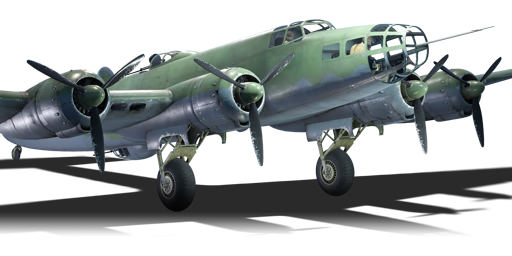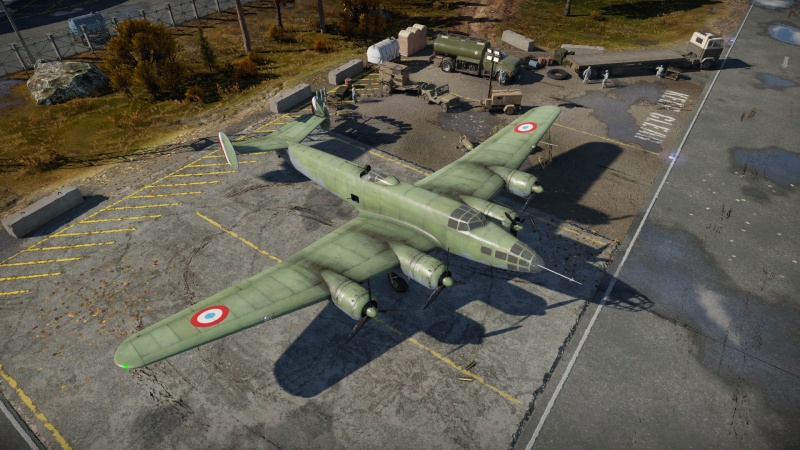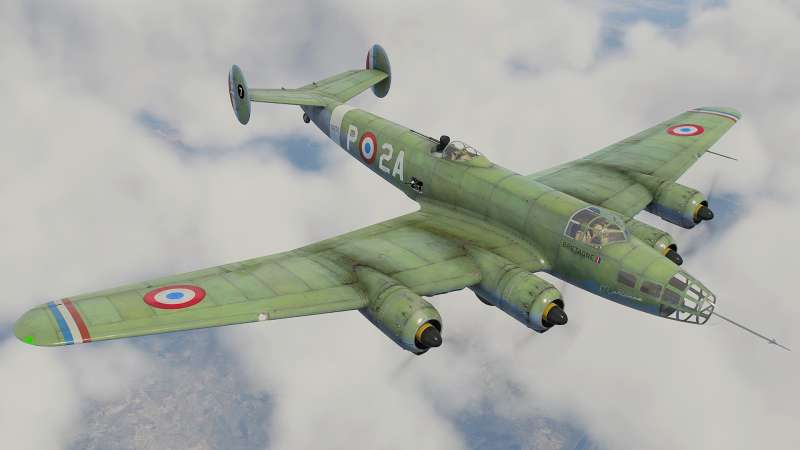M.B.162
Contents
Description
Based upon the civilian airliner Bloch M.B.160 already in service, the M.B.162 was intended to be a heavy bomber, designed by the Société des Avions Marcel Bloch, later known as Dassault Aviation after the end of WWII. The Bloch M.B.162, although based on a civilian airliner, shared very little with its unarmed counterpart, the most important changes to the design were the different wing configuration and, since it was meant for military usage, the main cargo bay was remodelled to fit bombs and other payloads. The aircraft was never used, since it was captured by Germany before it could enter service.
It was introduced in Update 1.73 "Vive la France". The M.B.162 is a very capable heavy bomber, considering the other indigenously designed bombers in the French tech tree. It works very similarly to the B-17, being relatively fast at high altitudes and carrying a large payload, enough to destroy a base in air battles or several ground targets, it can also be used in naval battles, but for this tasks, more agile torpedo and dive bombers work better. Its biggest issue however is the mediocre defensive armament, the 20 mm cannons only cover a small area, while the aircraft is also vulnerable to attacks from the entire frontal area, that lacks any sort of armament.
General info
Flight performance
The Bloch M.B.162 is the best indigenously-designed bomber France has at its disposal, behaving similarly to the American B-17. It is deceptively quick for a strategic bomber, and has an excellent climb rate that allows it to get to its safe altitude quickly. However, its excellent performance does not mean that it is lacking in bomb load or defensive armaments as one might expect. Although having a lower total capacity than the earlier N.C.223.3, it has a higher bomb load than any other indigenous French bomber and a defensive armament that matches the previously mentioned 223. All-in-all, the 162 can be seen as a sort of "Best of Both Worlds" of the French bomber tree, combining the excellent speed, climb rate and manoeuvrability of the lighter twin engined bombers with the bomb load and defensive armament of the heavy bombers.
| Characteristics | Max Speed (km/h at 3,000 m) |
Max altitude (metres) |
Turn time (seconds) |
Rate of climb (metres/second) |
Take-off run (metres) | |||
|---|---|---|---|---|---|---|---|---|
| AB | RB | AB | RB | AB | RB | |||
| Stock | 508 | 497 | 10300 | 27.8 | 28.3 | 8.5 | 8.5 | 650 |
| Upgraded | 571 | 537 | 26.7 | 27.0 | 16.2 | 11.6 | ||
Details
| Features | ||||
|---|---|---|---|---|
| Combat flaps | Take-off flaps | Landing flaps | Air brakes | Arrestor gear |
| ✓ | ✓ | ✓ | X | X |
| Limits | ||||||
|---|---|---|---|---|---|---|
| Wings (km/h) | Gear (km/h) | Flaps (km/h) | Max Static G | |||
| Combat | Take-off | Landing | + | - | ||
| 560 | 280 | 330 | 317 | 260 | ~6 | ~3 |
| Optimal velocities (km/h) | |||
|---|---|---|---|
| Ailerons | Rudder | Elevators | Radiator |
| < 325 | < 310 | < 420 | > 180 |
Survivability and armour
- No armour plating
- Six total self-sealing fuel tanks located in wings
Modifications and economy
Armaments
Suspended armament
The M.B.162 can be outfitted with the following ordnance:
- 6 x 200 kg No.1 bombs + 6 x 100 kg No.1 bombs (1,800 kg total)
- 4 x 500 kg No.2 bombs (2,000 kg total)
Defensive armament
The M.B.162 is defended by:
- 1 x 20 mm Hispano 404 cannon, dorsal turret (120 rpg)
- 1 x 20 mm Hispano 404 cannon, ventral turret (120 rpg)
- 1 x 7.5 mm MAC 1934 machine gun, 2 x beam turrets (500 rpg)
Usage in battles
The M.B.162 is a heavy bomber, and therefore should be flown as such. When you start a match, you will want to climb to 6-7 km in altitude to protect yourself from German and Italian fighters that will climb to intercept you. With both of the payload options, all bombs are needed to destroy a bombing base. It is worthy to note that the M.B.162 can be significantly more aggressive in Arcade, where its already excellent performance is boosted to further levels.
However, being a bomber, fighters will go out of their way to take you down (sometimes even at the expense of their own aircraft). Although the Hispanos are relatively inaccurate when fired in long bursts, they can be very devastating when fired in .5 second bursts at an aircraft's cockpit. But it is also to note that if you can hit an enemy with your turrets, they can hit you with their guns as well, which can be a large problem when fighting the multi-cannon armed Fw 190, Bf 109, C.202EC/C.205 and G.55 fighters that all mount the universally feared MG 151 that has access to the dreaded Minengeschoß round.
Manual Engine Control
| MEC elements | ||||||
|---|---|---|---|---|---|---|
| Mixer | Pitch | Radiator | Supercharger | Turbocharger | ||
| Oil | Water | Type | ||||
| Controllable | Controllable Not auto controlled |
Not controllable Not auto controlled |
Controllable Not auto controlled |
Combined | Not controllable 1 gear |
Not controllable |
Pros and cons
Pros:
- Powerful Hispano 404 cannons in dorsal and ventral turrets
- Effective bomb payload
- Respectable speed for a heavy bomber
- Excellent climb rate
Cons:
- Turrets cannot turn 360 degrees
- HS.404 cannons have low ammunition count
- No turrets protecting the front, perpendicular sides, or directly vertical
- Only 2 payload options, and both can only destroy 1 base
History
The M.B.162 was derived from the original civilian airliner Bloch M.B. 160 already in service and was built as mail plane by the Société des Avions Marcel Bloch. Société des Avions Marcel Bloch was a French aircraft manufacturer of both military and civilian aircraft which changed its name to Dassault Aviation after the end of World War II. The company was originally founded by Marcel Bloch (hence "MB" in the aircraft designations) who, after the war changed his name to Marcel Dassault, the Bloch M.B. 162 shares very few common points with his civilian counterpart, especially concerning its wings[1]
The aircraft in-game represents a heavy bomber created by Henri Déplante and Lucien Servanty in order to satisfy the A20 program concerning a category B5 bomber, which had a crew of 5 persons utilised for both day and night bombing. Three M.B.162s were ordered into production in 1937.
Unfortunately, the first flight of the M.B.162 wasn't until the 1st of June 1940 [1] and it never saw combat during the Battle of France (10 May to 25 June 1940). With the fall of France, the prototype of the M.B.162 fell into the Luftwaffe's hands and was used as transport aircraft for the rest of the war. After the war, the aircraft was returned to the French who utilised it in the Armée de l'Air and became the origin of the SNCASE Languedoc (post-war airliner, used for hypersonic experimentations).
Two versions of this plane existed: the MB.162.01 (prototype, one built) and the MB.162 Bn.5 (Production model, never produced).
Media
- Skins
- Videos
See also
Links to the articles on the War Thunder Wiki that you think will be useful for the reader, for example:
- reference to the series of the aircraft;
- links to approximate analogues of other nations and research trees.
External links
- Official data sheet - more details about the performance
- [Dassault Aviation] MB 162
- [Wikipedia] Bloch MB.162
References
- Citations
- Bibliography
- Dassault-aviation website L'avion MB 161, de taille légèrement inférieure et de performances comparable au B-17, ne possède que très peu d'éléments en commun avec les MB 160 et MB 161, son aile, notamment, est très différente., Dassault-aviation website, On-line.
- Dassault-aviation website La construction du prototype à Courbevoie est retardée jusqu'à la fin de 1939. Assemblé à Villacoublay après son transfert par route au printemps 1940, il effectue son premier vol le 1er juin 1940 équipé de quatre Gnôme et Rhône14 N 48/49de 1100 ch., Dassault-aviation website, On-line.
| Dassault Aviation | |
|---|---|
| WW2* | |
| Fighters | M.B.152C1 · M.B.157 |
| Bombers | M.B.162 · M.B.174A-3 · M.B.175T |
| Jet Aircraft | |
| M.D 450 | M.D.450B Barougan · M.D.450B Ouragan |
| Mystère | M.D.452 IIA · M.D.452 IIC · Mystere IVA |
| Super Mystère | Super Mystere B2 |
| Étendard | Etendard IVM |
| Super Étendard | Super Etendard |
| Alpha Jet | Alpha Jet E** |
| Mirage | |
| Mirage III | Mirage IIIC · Mirage IIIE · Milan |
| Mirage V | Mirage 5F |
| Mirage F1 | Mirage F1C · Mirage F1C-200 · Mirage F1CT |
| Mirage 2000 | Mirage 2000-5F · Mirage 2000C-S4 · Mirage 2000C-S5 · Mirage 2000D-R1 |
| Mirage 4000 | Mirage 4000 |
| Export | |
| M.D 450 | M.D.450B Ouragan |
| Mystere | Mystere IVA |
| Super Mystère | Sambad · Sa'ar*** |
| Mirage | Shahak · ▄Mirage 5BA |
| *The company was named "Société des Avions Marcel Bloch" before being renamed in 1947 | |
| **Jointly manufactured with Dornier Flugzeugwerke | |
| ***Israeli Super Mystère refitted with new avionics and an American engine | |
| See also | SABCA |
| France bombers | |
|---|---|
| Farman | F.222.2 · N.C.223.3 |
| Latécoère | Late 298D |
| Potez | Potez 633 |
| Liore et Olivier | LeO 451 early · LeO 451 late |
| Bloch | M.B.174A-3 · M.B.162 · M.B.175T |
| American | V-156-F · Martin 167-A3 · ▄A-35B · ▄SB2C-5 · B-26C · ▄PBY-5A Late · ▄PB4Y-2 |
| British | Lancaster MR.7 |






